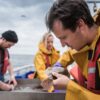Engaging anglers in the collection of Passive Integrated Transponder (PIT) Tag information represents a significant opportunity to enhance data collection efforts for fisheries management and research. Anglers, as frequent and passionate users of aquatic resources, are uniquely positioned to contribute valuable data on fish movements, growth rates, survival, and habitat use. In recent years, the affordability and accessibility of PIT tag readers have improved, making it more feasible than ever to involve anglers in this scientific endeavor. This blog post explores how to get anglers involved in collecting PIT tag information and the benefits of their involvement.
The Role of Anglers in PIT Tag Data Collection
Anglers can play a critical role in the collection of PIT tag data. By scanning fish for PIT tags before release, anglers can provide crucial information on the location and health of tagged fish. This data can be invaluable for tracking fish movements, assessing the success of stocking programs, and understanding fish behavior in response to environmental changes.
Steps to Involve Anglers in PIT Tag Data Collection
1. Educate Anglers on PIT Tagging: The first step is to educate anglers about what PIT tags are, how they work, and the importance of the data collected. Workshops, seminars, and informational brochures distributed at popular fishing locations can be effective tools for raising awareness.
2. Make PIT Tag Readers Accessible: The decreasing cost of PIT tag readers has made it more feasible to distribute these devices to anglers. Agencies and research organizations can offer readers on loan or at a subsidized cost to interested anglers. Additionally, developing partnerships with fishing clubs and associations can facilitate the distribution of readers.
3. Simplify Data Reporting: Creating an easy-to-use platform for anglers to report their findings is crucial. Mobile apps, websites, and hotlines can be developed for anglers to report the unique ID of the PIT tag, the location of the catch, and other relevant data such as fish size and condition.
4. Incentivize Participation: Offering incentives can significantly increase angler participation in PIT tag data collection. Rewards can range from recognition in newsletters and websites to gear, fishing licenses, or even participation in exclusive fishing events.
5. Establish a Community of Citizen Scientists: Building a community of anglers who are engaged in science can foster a sense of ownership and pride in contributing to fisheries research. Social media groups, online forums, and community meetings can help maintain interest and engagement over time.
Benefits of Angler Involvement in PIT Tag Data Collection
Increased Data Collection: With anglers participating in data collection, researchers and fisheries managers can access a wealth of additional data, covering wider geographic areas and time periods than would be possible through traditional research efforts alone.
Cost-Effectiveness: Utilizing the angling community as citizen scientists is a cost-effective way to supplement research efforts. The affordability of PIT tag readers further enhances this advantage, making widespread data collection feasible.
Enhanced Resource Management: The data collected by anglers can lead to better-informed management decisions, contributing to the sustainability of fish populations and the improvement of fishing opportunities.
Community Engagement: Involving anglers in scientific research promotes a deeper understanding of and appreciation for aquatic ecosystems. This engagement can lead to stronger support for conservation initiatives and responsible fishing practices.
Conclusion
The involvement of anglers in collecting PIT tag information offers a promising avenue for expanding research capabilities and improving fisheries management. By leveraging the accessibility and affordability of PIT tag readers, along with a strategic approach to education and engagement, fisheries managers can tap into a valuable and enthusiastic source of data collection. This collaborative effort not only enriches scientific research but also fosters a stronger connection between anglers and the aquatic environments they cherish.










Add comment